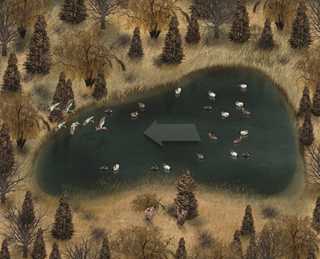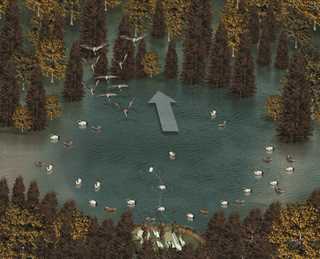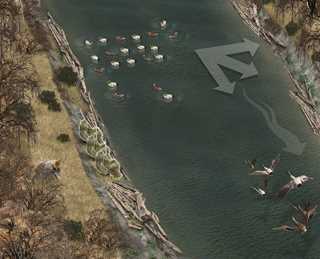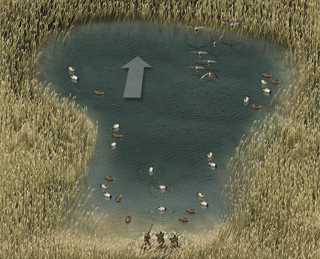Five Small Spreads for Ducks
Here's how to make the most of a limited number of decoys in five common waterfowl habitats
Here's how to make the most of a limited number of decoys in five common waterfowl habitats
By Wade Bourne
When it comes to decoy spreads, many hunters subscribe to the "bigger is better" theory. They believe that the power of a spread's persuasion is directly proportional to the number of decoys it contains. So these hunters amass, deploy, and maintain hundreds-or even thousands-of decoys. Of course, there's nothing wrong with this approach. A gigantic spread will often pull ducks in like a magnet.
But many hunters, especially freelancers, prefer not to deploy such an outsize spread. Some can't bear the expense. Others simply don't have the time or inclination to transport, deploy, and pick up a large spread every time they hunt.
The truth is, in many situations a small spread will work just as well as a big one. A waterfowler with two dozen decoys and a healthy dose of hunting savvy can still enjoy quality gunning. Many times it's more about "how" than "how many." Following are five small decoy spreads, from members of the Avery Outdoors pro staff, that are designed to pull ducks into close shooting range in specific hunting situations.
Rusty Burnam knows that when rivers rise over their banks in western Missouri, ducks will take advantage of the freshly flooded habitat. He scouts along back roads near a chosen river, watching for ducks piling into a hidden slough or low-lying field.
"When we see birds hitting a spot, my partner and I often have to hike in to hunt them," Burnam explains. "We'll carry in a couple dozen decoys and a pair of marsh seats to hide in whatever natural cover is available. Also, we will set out a spread that looks realistic and is highly visible to working ducks."

Photo © Kevin Hand
For starters, Burnam uses Greenhead Gear's new pro-grade January mallard decoys, which are painted with more white on the drakes' backs to give the appearance of birds in full breeding plumage. Sometimes he also brings along a few drake shoveler and pintail decoys to add even more white to his spread. "Decoys with a brighter, whiter color scheme are a lot more visible from longer distances, and when your decoys show up better, you can use fewer of them," he says.
Burnam sets half of his spread in a group well off the bank, with the wind at his back whenever possible. However, if the wind is blowing at a quartering angle, he moves this group of decoys slightly upwind of his shooting position. In both cases, he sets his decoys with lots of space between them so they appear to be birds resting in comfort and security.
Burnam scatters his remaining decoys along the banks-a pair here, three there. "I don't try to form a clearly defined fish hook or J, but I do position my spread to force incoming ducks to land in front of the main group of decoys at a range of around 25 yards," he says.
Kevin Carter specializes in hunting "green timber" in the White River bottoms of east-central Arkansas. When backwater flooding inundates tracts of bottomland hardwood forest along the river, mallards and other dabblers flock to the flooded woods to feed and rest. Carter and his hunting partners scout by boat in the afternoon to find an opening in the timber that is holding a good concentration of ducks.
They take a minimalist approach to decoys and other waterfowl gear. "We never bring more than two dozen decoys with us," Carter says. "We're primarily hunting mallards, so we use only mallard decoys. I like the Greenhead Gear Hot Buy decoys-the small economy models-because they weigh less and take up less space in the boat."
When deploying his spread, Carter sets a small group of decoys on the upwind side of the hole and scatters the rest along the edges of the trees in a horseshoe pattern. He sets these decoys in pairs to look like drakes and hens that have paired up. To put ripples on the water and add movement to the spread, he rigs three decoys on a jerk string.

Photo © Kevin Hand
"We also splash and kick the water while ducks are working, so we always set a few decoys close to where we're hiding. We prefer standing in shallow water next to trees on the upwind edge of the hole. When the water is too deep to stand in, we hunt from a boat, which we hide in thick brush or under overhanging limbs," he says.
Carter doesn't hesitate to move his decoys during the hunt if necessary. "Sometimes the birds will hover over the hole and then pitch to one side or the other, depending on the wind direction. So we often have to adjust our spread to keep ducks landing in the middle of the hole. For instance, if they're veering to the right side, we'll move most of our decoys there to force them to land in the middle. We will also move our decoys to keep them out of the shadows and in the sunlight so ducks can see them."
When winter rains come to western Washington, rivers back up into ditches on the region's many dairy farms, flooding low-lying pastures with expanses of sheet water. This seasonal wetland habitat draws clouds of wigeon and pintails from the coast, but a lack of cover makes hunting them a challenge. Mike Reed has devised a system to conceal hunters and decoy ducks in these pastures and in other wide-open habitats such as flooded grainfields.
"First we get an exact fix on where the ducks are resting and feeding. Being in the right location is absolutely critical," Reed says. "Next we'll slip in after dark and leave scattered piles of tall grass or brush in the area the birds are using. We cut this natural cover with a power hedger and carry it in with us. We leave several piles in a 30-yard- to 40-yard-wide area. Then we wait three or four days for the ducks to get used to this new cover."
When the birds are comfortably using the area again, Reed and a hunting partner go in before dawn and set up layout blinds equipped with waterproof NeoTubs. They completely cover the blinds with canary grass to make them look like the other piles of cover placed in the hunting area. "We haul in more grass than decoys," he says.
Reed then sets out a mixed spread of 18 Greenhead Gear pro-grade wigeon, pintails, and green-winged teal. He arranges the decoys in what he calls a "lane spread." With the wind quartering over his shoulder, he sets 10 to 12 decoys in a loose line in front of the blinds. Next he places a small group of decoys, consisting of a combination of wind-powered wing-spinners and feeder decoys rigged on jerk strings, about 25 yards upwind of the blinds.

Photo © Kevin Hand
"Every one of these decoys provides some type of motion," Reed says. "In such an open environment, it's important to have a lot of movement to draw the ducks' attention away from the layout blinds. When they're coming in, they'll usually focus on all the commotion, and that's where they'll want to land."
As the season progresses, Reed reduces the number of decoys in his spread. "By the last few weeks, birds are really spooky from gunning pressure, so we dial our spread back even more. We may just put out a half-dozen motion decoys upwind of our blinds. We do very little calling. Instead, we just work the jerk strings and watch the ducks come straight in."
In the prairie pothole country of eastern North Dakota, the landscape is pockmarked with small wetlands, but not all of them hold ducks. "Up here, it's more about scouting than anything else. Be in the right spot, and you can get away with using a small number of decoys and hiding in the cattails at the water's edge," Joe Fladeland says. "I like to hunt smaller potholes and sloughs where ducks loaf after feeding in the grainfields at dawn."
When he sets up to hunt in one of these midday honey holes, he places his decoys in a loose configuration to look like a group of relaxed, resting birds. "Two dozen decoys are more than enough," he says. "I use Greenhead Gear pro-grade mallards in a variety of body postures, including swimmers, butt-up feeders, surface feeders, and no-head feeders."
Fladeland sets a small group of decoys directly in front of his shooting position. Then he scatters the remaining decoys around the edges of the pothole, leaving an opening in the middle. "I'll also rig a few decoys on a jerk string where I want the birds to land. They'll key on the movement as they're coming in," he says.

Photo © Kevin Hand
One more thing is crucial when hunting prairie potholes-a good marsh seat. "A marsh seat will not only provide comfort, but also allow you to sit close to the water and down low in the cover, where you'll be less visible," Fladeland says.
When a cold snap freezes shallow marshes and ponds in central Kansas, ducks often move to free-flowing rivers to find open water. Mallards and other dabblers typically fly out at dawn to feed in nearby grainfields and then return to rivers later in the morning to loaf. At these times, Casey Self and his hunting partners follow the ducks, focusing their scouting efforts on river sandbars frequented by resting birds.
"We're looking for puddle ducks-mostly mallards-resting in bunches of 25 to 50 birds on the sunny side of the river. We find them by scouting from the bank or in a boat," Self explains. "We scout mostly during midday, when the ducks have already come back to the river after feeding."
Once these hunters locate a concentration of ducks, they return the next morning and deploy their decoys in a pattern that funnels returning birds into easy shooting range. "We never put out more than 18 decoys, usually Greenhead Gear oversize mallards," Self says. "We rig them Texas-style so we can put them out and pick them up quickly. We set our decoys in a blocking pattern just upriver from where we hide. Ducks almost always land against the current, just like the wind. With this setup, the birds usually hit the water right in front of us."

Photo © Kevin Hand
For concealment, Self and his hunting partners wear ghillie suits and simply sit or lie back against the river bank in whatever natural cover is available. "Most of the places where we set up have timber or tall grass close to the water. Wearing the ghillie suits, we really blend into the background and don't have to bring along layout blinds or build a temporary blind. I hide my retriever in a dog blind on the bank behind us. It's quick, easy, and the ducks never see us," he says.